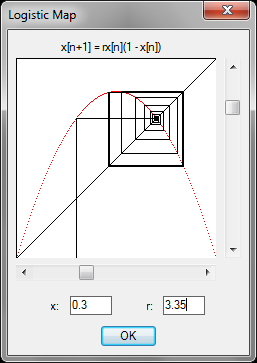Search the Community
Showing results for tags 'iterate'.
-
As many of you will know, I am currently studying for a degree in Mathematics, and, as part of the course, we study the dynamics of such functions as the Logistic Map. I've always been fascinated by this ostensibly simple map, which produces astoundingly complex dynamics resulting in chaos if a single parameter is varied. Quick Overview of the Logistic Map The Logistic map was originally devised as a population model, to measure the growth of a population, noting that the rate of reproduction of a species is proportional to the existing population and restricted by the available resources and competition for such resoures. We are iterating the difference equation: x[n+1] = rx[n](1-x[n]) For varying values of 0 Function maximum occurs at r/4, hence for 0 For 0 For 1 As r approaches 3, convergence to the fixed point x=r-1/r becomes increasingly slow, and a periodic point of period 2 appears when 3 From here we have a period-doubling cascade with the period doubling at a rate of approximately 4.669 (the Feigenbaum Constant). For r > 3.57 chaos emerges, with 'islands of stability' for various values of r at which periods of order 5,6,7 emerge. For r=4 the interval [0,1] is mapped to a set resembling a Cantor Set, with Hausdorff Dimension of about 0.538. A Visual Study of the Logistic Map To view the general dynamics of the Logistic Map, I have created a program where the parameter 'r' and the initial state 'x' can be varied, and the long-term behaviour of the model is displayed. To run the program: Download the attached Logistic.lsp and Logistic.dcl files. Ensure the Logistic.dcl file is located in an AutoCAD Support Path. Load the Logistic.lsp like any other LISP program (for instructions on how to do this, see here). Run the program by typing 'Logistic' at the AutoCAD command-line. I hope that I have sparked some interest in this area of mathematics and look forward to discussing the subject with the community. Enjoy! Lee logistic.lsp logistic.dcl


